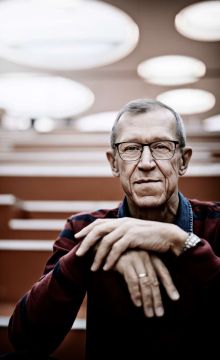
The man who makes the magic happen
Professor Sergey I. Bozhevolnyi is a pioneer within the research areas named Plasmonics and Nano Optics. Both hands are needed if you want to count the phenomena and concepts that can be ascribed the Danish top researcher of Russian origin. This is due to an indomitable will, a great imagination and a belief in the impossible. Now he is the latest recipient of the Villum Kann Rasmussen Annual Award in Science and Technology.
Professor Sergey I. Bozhevolnyi is head of the Centre for Nano Optics of the Mads Clausen Institute at SDU. A few discrete wrinkles around the eyes give away that his birth certificate might tell the truth when it says that he was born in 1955, but at first sight he appears athletic and neither as the stereotype of a professor nor as a man aged 63.
The contrast to his age becomes larger when he starts talking about his research, because the blue eyes glitter and immediately generate sparks in what easily could be mistaken as juvenile enthusiasm as soon as we touch upon the topic of nano optics. He radiates his passion. It is this zeal and enthusiasm that underlie the fact that Sergey I. Bozhevolnyi built up a research area from scratch. It is this eagerness that led to his name being published on more than 450 research articles.
But we’ll leave the research articles aside for a moment. Instead, we’ll move to a quote from Sergey I. Bozhevolnyi’s favourite book, Alice in Wonderland:
“There’s no use trying”, she said: “one can’t believe impossible things.” “I daresay you haven’t had much practice”, said the Queen. “When I was your age, I always did it for half-an-hour a day. Why, sometimes I’ve believed as many as six impossible things before breakfast!”
Master of light
Sergey I. Bozhevolnyi has the gift of seeing pigs fly. Until 20-25 years ago, it was broadly accepted that one cannot distinguish structures in a light microscope that are smaller than approx. half the wavelength of the light that is needed to examine the sample. It was formulated in a physical law by Ernst Abbe in 1873 and is due to the refraction of light.
Today, by using nanoscopy, it is meanwhile possible to see details that are a thousand times smaller than the wavelength of light. By studying the very smallest building blocks – molecules and atoms – it is possible to understand how the world is connected. The impossible has become possible. Sergey I. Bozhevolnyi’s research has added to this .
Super effective, future solar cells
With Sergey I. Bozhevolnyi leading the way, the Nano Optics unit at SDU has fully harnessed the new technology. The research team is, among other things, working on using metals to convert light into electricity with an extremely low loss. The new technology opens up for new possibilities of producing solar cells. The research team found a new approach to turn a shiny metal like gold into something completely black by nanostructuring the surface in a special way.
When the metal surface has turned black it means that most of the light that hits the surface will be absorbed by the metal, i.e. the light will be converted into heat on the dark surface. This heat can be used to produce new light that can be converted to electricity with an incredibly high efficiency.
Quantum computers no longer unrealistic
Sergey I. Bozhevolnyi also obtained a breakthrough in controlling light in circuits on nanoscale. This could become the cornerstone in future quantum computers. In collaboration with Stanford in the US, SDU Nano Optics developed a technology that transports light through an air gap in the metal via so-called surface plasmons. An air gap of 25 nanometres.
- When the information from the internet ends on the computer, it goes from being led by fast light to being processed by slow electrical circuits. A bottle neck effect occurs that we are working on to eliminate, Sergey I. Bozhevolnyi says.
Colour without paint
His research has also been contributing to the fact that today it is possible to colour things by means of nanostructures rather than by using pigments. Instead of paint you change the topological structure of the surface and by this get it to change colour. We know the technique from nature where beautiful butterflies’ wings and peacock tails make use of a similar concept.
- We also know it from old, coloured windows in churches. And exactly these windows show that the technique is incredibly fast compared to normal paint. The colour does not fade in the sunlight but can last for thousands of years, Sergey I. Bozhevolnyi explains.
Since we are down to a resolution of more than 100.000 dpi (dots per inch), the technique opens up for a vast number of options for application. Namely because you can store information within an area that is a lot smaller than the human eye can perceive. As an example, let’s take a random full stop in this text.
- With this technique, such a full stop can contain a coloured SDU logo or one of Picasso’s sketches due to the high resolution.
Invisible cloak theoretically possible
Let’s go back to Alice in Wonderland for a moment. Here, that is to say, the protagonist experiences all kinds of impossible things: to grow and to shrink depending on what she ingests, to swim in her own tears, a baby that is transformed into a pig, a cat that can become invisible. Exactly the thing about becoming invisible is not as unlikely as it was back then. Sergey I. Bozhevolnyi tells us that it is possible to make an invisible cloak.
- In theory, yes. Practically though it is not yet possible. It is based on what is called metamaterials. But it has proven to be difficult to produce the required metallic nanostructures in 3D.
But speaking about metamaterials in 2D, Sergey I. Bozhevolnyi has been one of the absolute pioneers. And this has far-reaching perspectives if you, for example, think of optical lenses like the ones we know in cameras. To wit, it is possible to make these metasurfaces almost indefinitely thin while keeping the same functionality. So, if you think your mobile phone is thin today, just wait until you see the mobile phones of the future with camera lenses in nano-thickness.
On the acknowledged Clarivate list of highly-cited researchers second year in a row
As appears from the above, it is difficult to pinpoint one single research breakthrough when it comes to Sergey I. Bozhevolnyi. The line of phenomena and concepts that can be assigned to his research is so long that it is only possible to make random picks, which, however, is far from acclaiming his research the way it deserves.
But to put this into perspective, it can be mentioned that only a few articles about nano optics were published when Sergey I. Bozhevolnyi entered the research field at the end of the 1990s. Today, more than 5000 articles are published per year, and a large number of these lead back to Sergey I. Bozhevolnyi which is why he now – for the second time in a row – can be found on 2018 Clarivate list of highly-cited researchers as the only researcher from Scandinavia. One can rightly call Sergey I. Bozhevolnyi a true pioneer.
Through the best Soviet school
But how do you end up being a world leading researcher within the interaction between light and nanostructures which, over 40 years, has provided ground-breaking research that has transformed an entire research field?
For Sergey I. Bozhevolnyi’s part it has been on the cards. His father taught physics and his mother mathematics. There has never been any doubt that he himself should follow either in his mother’s or his father’s footsteps.
- I have always committed myself to understanding how the world around me works, so I chose physics where it was possible to do experiments.
The young Sergey I. Bozhevolnyi loved outdoor life and to be active, so he considered to study close to the Caucasus where he fancied to hike, but in the end, he chose Moscow Institute of Physics and Technology – a top-class university in the Soviet Union of that time.
- It was tough, and for the first time I experienced that I wasn’t the best. The first year was really hard but Moscow Institute of Physics and Technology is built up around the implementation of research in teaching, so already after a few semesters we stood in the laboratories, Sergey I. Bozhevolnyi says.
And in the laboratories, led by laser-inventor and Nobel Prize winner Alexander Prokhorov, practically minded Sergey I. Bozhevolnyi felt good. Even prior to graduation, Sergey I. Bozhevolnyi had published his first research article.
As one of the very few in the then Soviet Union, he was given the opportunity to go abroad in the West which led him to Aalborg University where he worked together with the visionary Ole Keller. It was under Ole Keller’s wings that Sergey I. Bozhevolnyi set the course for nano optics because he saw a host of opportunities within the research field.
- I had lots of ideas, but as a young man I was afraid – almost scared – of waking up one morning without any research ideas but getting older made me calm down. You may call it experience. In any case I am sure that I’m not running out of ideas, Sergey I. Bozhevolnyi laughs.
When you cannot see the horizon
Today, he’s the one supervising PhD students and postdocs at SDU, while, in his spare time, plunging into long distance swimming in the open sea. For one thing, Sergey I. Bozhevolnyi has swum around Christiansborg several times and has crossed Vejle Fjord.
- There is something exiting about not being able to see your goal at the horizon when you are floating in the water and have to cross a fjord or a large strait.
But exactly to have the goal in view when nobody else can see it is one of Sergey I. Bozhevolnyi’s biggest strengths. Says Jonas Beermann who today is associate professor and colleague of Sergey I. Bozhevolnyi at SDU Nano Optics. He has been supervised by Sergey I. Bozhevolnyi when he first started as a PhD student and since as a postdoc.
- He is an excellent supervisor with the ability to keep one’s nose to the grindstone. It was he who got me to deliver results week after week. Even if I sometimes only solved small problems. He’s good at sorting things and knows what to focus on. This also means that we, who are fortunate enough to work with him, do get results, says Jonas Beermann.
Apart from being the progenitor of the research field nano optics, Sergey I. Bozhevolnyi has also contributed to Danish research by having supervised more than 20 postdocs and 20 PhD students. In 2011, he was elected to Danmarks Naturvidenskabelige Akademi. With an academic career so comprehensive and productive, it is appropriate to end with yet another of Sergey I. Bozhevolnyi’s favourite quotes from Alice in Wonderland:
“Well, in our country”, said Alice, still panting a little, “you’d generally get to somewhere else — if you run very fast for a long time, as we’ve been doing.” “A slow sort of country!” said the Queen. “Now, here, you see, it takes all the running you can do, to keep in the same place. If you want to get somewhere else, you must run at least twice as fast as that!”
Sergey I. Bozhevolnyi was appointed OSA (Optical Society of America) Fellow in 2007 and received Fyens Stiftstidendes Forskerpris. Sergey is employed at University of Southern Denmark since 2008.
Professor Sergey I. Bozhevolnyi

Professor Sergey I. Bozhevolnyi is a pioneer within the research areas named Plasmonics and Nano Optics. He can be found on Clarivate list of highly-cited researchers for the second year in a row.